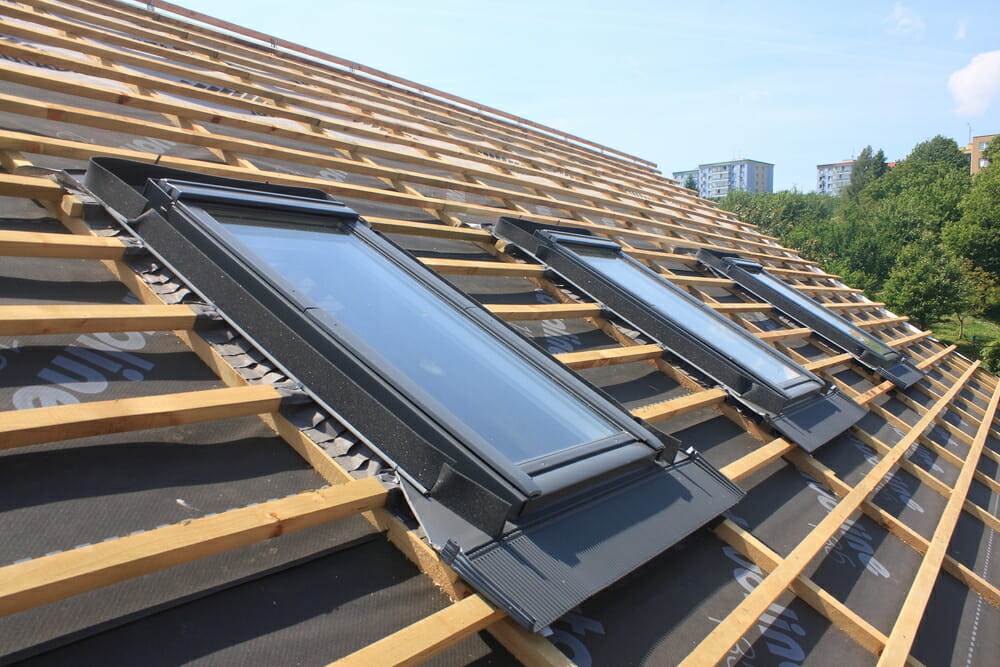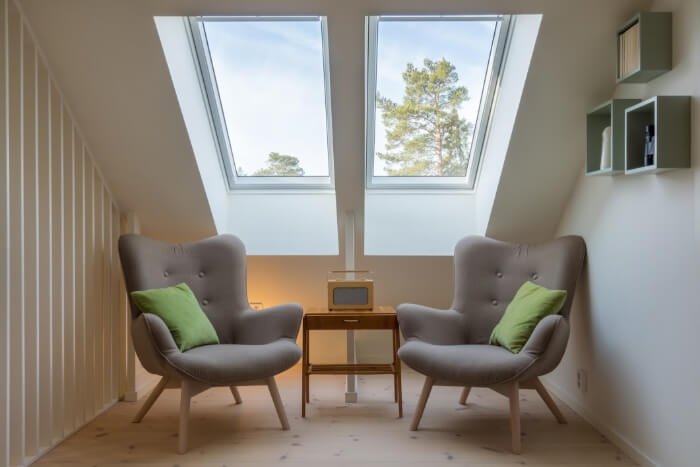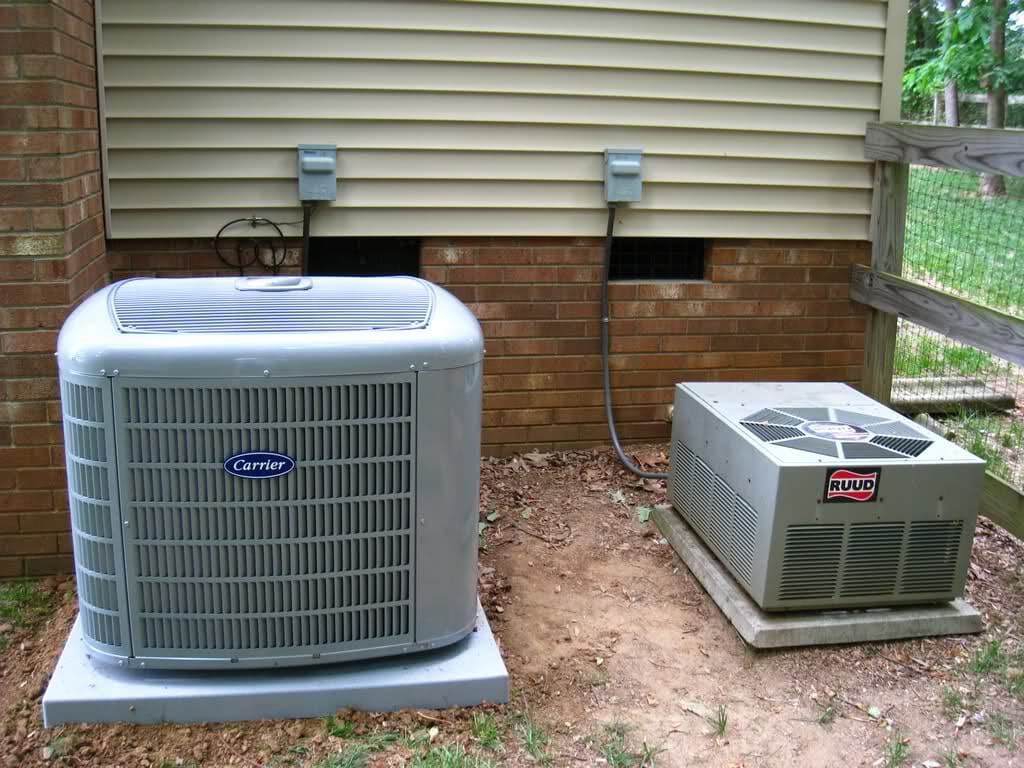Are you doing a windows project?
Modernize can pair you with three to four pros in your area, so you can compare options and save time and money.
- Choosing the Right Skylight for Energy Efficiency
- What Helps Make a Skylight Energy Efficient?
- Choosing the Right Skylight for Your Space
- Skylight Orientation Plays a Role in Solar Heat Gain
- Consider Skylight Slope for Best Results
- The Best Glass for Skylights
- Skylight Size and Its Impact on Energy Usage
- How to Make an Existing Skylight Energy-Efficient
Choosing the Right Skylight for Energy Efficiency
Skylights are among the hardest-working windows in your home, offering natural light, improved ventilation, and an added sense of space. When selected carefully, they can reduce reliance on artificial lighting and help manage heat, ultimately lowering energy costs. However, not all skylights are created equal, especially in terms of energy efficiency.
Inefficient skylights can increase your heating and cooling costs by up to 40%. Since skylights are essentially openings in the roof — your home’s primary barrier against weather — choosing the right one is essential to avoid energy loss.

What Helps Make a Skylight Energy Efficient?
Skylights have the potential to offset lighting costs by providing natural light during the day and offering ventilation for excess heat or moisture. However, energy efficiency depends on several factors, including glazing, insulation, and placement. Without features like double glazing, insulated glass, or proper shading, skylights can let in excessive heat or cold, raising your energy bills.
Choosing the Right Skylight for Your Space
When deciding on a skylight, consider what you need from the installation:
- Ventilation: If you’re looking for better airflow, a vented skylight with weather sensors might be ideal.
- Natural Light: For light and design, an angled skylight placed on a north-facing roof provides the best combination of light without excessive heat.
- Solar Heat Gain: If you want to capture solar heat during the winter to reduce heating costs, consider placing the skylight on a south-facing slope.
Understanding your needs will help you choose the right skylight type and placement.
Skylight Orientation Plays a Role in Solar Heat Gain
The orientation of your skylight plays a significant role in its energy efficiency.
- North-Facing Skylights: Ideal for warmer climates, as they minimize passive solar heat gain and help keep cooling costs low.
- South-Facing Skylights: Best for colder climates where solar heat can contribute to warming the home in winter. However, be mindful that they can increase cooling costs in the summer.
- East or West-Facing Skylights: Provide a balanced solution for temperate climates, offering some heat in winter without too much excess in summer.
Consider Skylight Slope for Best Results
The slope of your skylight also affects its efficiency. A steeper angle minimizes solar heat gain, making it a good choice for warmer months when sunlight is more direct.
Find the Right Contractor for Your Windows Project
Whether you’re ready to begin your project now or need some expert advice, our network of contractors are here to help. With a few simple questions, we’ll find the best local professionals for you
- For warmer climates, a steeper slope (around 35-45 degrees, based on your geographical latitude) will help reduce the summer heat.
- Flat or low-slope skylights: These allow more heat to enter the room in the summer, which may lead to discomfort or higher cooling costs.
The Best Glass for Skylights
The glass used in your skylight is just as important as the installation itself. Consider the regional climate and select glazing that meets local energy performance standards. Look for energy-efficient glass with coatings that help control heat transfer, such as low-E coatings.
You can also take our glass type quiz if you need help deciding on glazing and any additional coatings for your skylight. That way, you can have all the lighting benefits of a new skylight while staying comfortable in your home year-round!
Skylight Size and Its Impact on Energy Usage
Larger skylights provide more light but also increase heat loss or gain, which can drive up your energy bills. The Department of Energy suggests limiting skylight size to 5% of the room’s total area if it already has many windows. If the room has few windows, a skylight can cover up to 15% of the room’s total area, but be mindful of the trade-off between light and energy efficiency.

How to Make an Existing Skylight Energy-Efficient
If you already have a skylight, there are easy ways to improve its energy efficiency without replacing it. Adding shades, blinds, or screens can block excessive heat and provide better control over temperature. Many modern skylight shades are automated, allowing you to adjust them with a remote for maximum convenience.
Skylights can be a valuable addition to your home, providing natural light and improving ventilation while potentially lowering energy costs. However, it’s crucial to select the right skylight and installation type based on your home’s needs and climate. Consider energy-efficient glass, proper placement, and the right size to ensure that your skylight enhances comfort and efficiency year-round.
Find the Right Contractor for Your Windows Project
Whether you’re ready to begin your project now or need some expert advice, our network of contractors are here to help. With a few simple questions, we’ll find the best local professionals for you
Reviews from Real Homeowners
Welcome to Homeowner Resources! We are the Modernize blog. Modernize pairs more than 3 million homeowners a year with pre-vetted contractors in their area. This blog started because we believe homeowners should know everything about their homes, from how their HVAC works to which front door colors they might love. On Homeowner Resources, you can find information on every part of your home, right down to how you can negotiate with contractors to get the best price. Here's more about the blog.
Need a contractor? Learn more about how Modernize finds the right pro for you.



